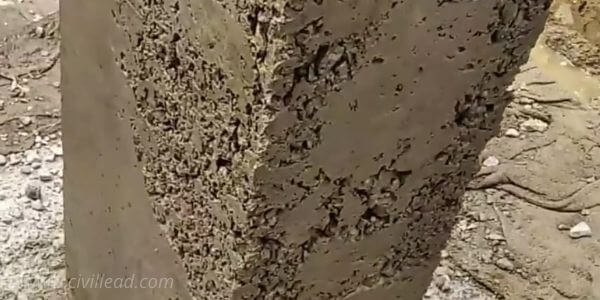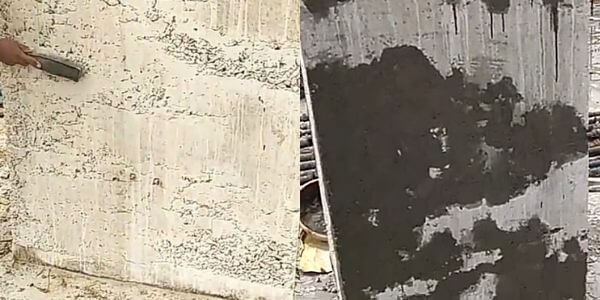Table of Contents
What is Honeycomb in Concrete?
When the finished concrete surface has a rough texture, cavities, voids on the surface, and gaps between concrete and the reinforcement because concrete could not fill that space is termed ‘Honeycombs in Concrete.’ It resembles a honey bee nest.
Honeycomb in concrete is a severe issue that decreases the concrete strength and makes the reinforcement vulnerable to rusting.
Concrete is used to construct different structural members like foundation, beam, column, slab, etc. According to structure design, when concrete is poured into formwork, it flows like a liquid.
Dense places often remain unfilled for various reasons, forming voids and cavities that look like honey bee nests if the concrete is not poured and vibrated correctly, resulting in gaps uncovering the aggregate.
Honeycomb in concrete reduces the strength and gives passage for water, which corrodes bars.
Corrosion is a procedure that continues via bars, even in suitable concrete resulting in losing bond between steel and concrete, which is very harmful to the safety and lifespan of concrete structures.
Honeycombs on the sides surface of concrete members like beams and columns can be found when shuttering is removed if not appropriately cast.
Advanced techniques like ultrasonic testing etc., can only detect honeycombs inside the concrete mass.

Effects of Honeycomb in Concrete
- Honeycomb reduces the load-bearing capacity of the concrete member of the structure.
- It offers an easy passage for water to reach reinforcement bars, leading to corrosion.
- It affects the durability of concrete and reduces the structure’s life span.
- It gives a bad appearance and is the symbol of poor workmanship.
Causes of Honeycomb in Concrete
- Using concrete of poor workability may lead to honeycomb.
- Use of stiffy concrete mix that is hard for its placing.
- The excess water-cement ratio causes the separation of coarse aggregate particles from the concrete mass, resulting in a honeycomb.
- Inappropriate vibration and excess vibration cause coarse aggregate particles to settle down and slurry come on top.
- Dropping of concrete from a height and discharging of concrete from a poorly designed mixture show a tendency of honeycomb.
- A specific place like column beam junction where steel bars are closer or dense doesn’t allow concrete to flow appropriately.
- Large aggregate in excess quantity in the concrete mix may cause honeycomb.
- Use of poor formwork that is not watertight and rigid.
- Providing less cover than required for the concrete member.
- Inappropriate bar placement at column beam junction
How to avoid honeycomb in Concrete?
- The freefall of the concrete should not be more than 1.5 meters.
- A concrete mix of suitable workability should be used.
- Concrete mix has an appropriate fine aggregate particle to seal the voids between the coarse aggregate.
- Concrete should be adequately compacted and placed appropriately to avoid segregation.
- The formwork should be rigid, watertight, and sealed properly to not allow penetration through it.
- At junctions like column and beam, joints placing of concrete should be done carefully. Concrete mix with 20 mm and down aggregate with adequate water and cement is preferable for such places to prevent honeycomb. Tapping shuttering from its outer side by a wooden hammer during concrete placing and vibration helps prevent honeycomb significantly.
- In the case of the beam and column, using a small size needle (25 mm or less) with a vibrator at complex places during concreting will help prevent honeycomb.
- Tapping shuttering from its outer side by a wooden hammer during concrete placing will help to avoid honeycomb.
Remedy For Honeycomb In Concrete

By following the steps mentioned above, try to avoid honeycomb in concrete. But due to any reason, honeycomb appears on the concrete surface; it can be repaired by the following method.
Holcomb repair procedures include:
- Removal of loose material.
- Cleaning.
- Repairing material application.
- Curing to achieve the required strength.
Usually, the repair process for honeycomb in concrete members like columns and beams is as follows:
- Firstly remove loose aggregate or concrete from the honeycomb affected area with the help of a wire brush. Avoid using heavy force like a chipping hammer to prevent sound concrete from damage.
- Now clean the surface, remove dirt and fine particles, if any, and apply water to keep the surface wet before the application of repair material.
- Fill cracks and voids with a suitable material like non-shrinkage grout by injecting via a pressure pump.
- If the honeycomb affected area is significant, make pitched holes for sound bonding.
- Install formwork if needed to pour the grout.
- If not using formwork, apply appropriate high-strength non-shrinkage grout.
- If honeycomb depth is more than 5 cm, the filling should be done in layers of thickness 15 mm. Before applying the next layer, It is preferable to wait for 30 minutes.
- The strength of repairing material should equal or more to the concrete of structural members.
- If necessary, give texture and apply color to the repaired surface to match the surrounding surface.
- If using formwork, removing it after 12 to 24 hours depends on the material used for repair. To achieve the required strength, cure the repaired surface properly.
Also, Read
Prestressed concrete – Definition, Method, Advantages
Plum Concrete – Purpose, Ratio, Specification & Uses
What is Development Length? – Complete Guide
Compaction Factor Test For Concrete